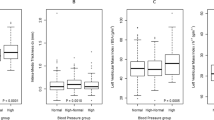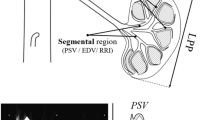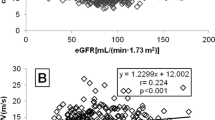Abstract
We evaluated the relationship between renal resistive index (RRI) of the intrarenal vasculature and cardiovascular (CV) organ damage such as left ventricular hypertrophy (LVH), diastolic dysfunction and carotid atherosclerosis in a large sample of hypertensive patients. 566 hypertensive patients underwent echocardiography with conventional Doppler and Doppler tissue imaging (DTI), carotid and renal ultrasonography. In addition, lipids profile, creatinine in serum, and urinary albumin concentrations were determined. The patients were divided according to their RRI values in 2 groups: <70 and ⩾70. Subjects with high RRI were older, had higher systolic and pulse pressure (PP) and more years of hypertension, compared to those with low RRI (P<0.0001). Patients with the higher RRI showed an increased left ventricular mass index (LVMI) and carotid intima–media thickness (IMT) with a higher prevalence of LVH, carotid plaques and microalbuminuria (P<0.001). There were differences in overall diastolic parameters, in particular when evaluated by DTI (P<0.001). A positive correlation was found between RRI and age, PP, carotid IMT, LVMI, SBP and a negative correlation was found with DTI diastolic parameters (P<0.001). Age, PP, carotid IMT and LVMI were independently related to RRI. While, RRI was independently related to IMT and IVRT. RRI, especially the higher values, are positively correlated with target organ damage in hypertensive patients, indicating that renal vascular resistance is related to morphologic and hemodynamic alteration of the CV system. The evaluation of RRI could predict the presence of early CV damage and provide an accurate estimate of overall risk.
This is a preview of subscription content, access via your institution
Access options
Subscribe to this journal
Receive 12 digital issues and online access to articles
$119.00 per year
only $9.92 per issue
Buy this article
- Purchase on Springer Link
- Instant access to full article PDF
Prices may be subject to local taxes which are calculated during checkout

Similar content being viewed by others
References
Mancia G, Volpe R, Boros S, Ilardi M, Giannattasio C . Cardiovascular risk profile and blood pressure control in Italian hypertensive patients under specialist care. J Hypertens 2004; 22: 51–57.
Kannel WB . Cardioprotection and antihypertensive therapy: the key importance of addressing the associated coronary risk factors (the Framingham experience). Am J Cardiol 1996; 77: 6B–11B.
Alberti D, Locatelli F, Graziani G, Buccianti G, Redaelli B, Giangrande A et al. Hypertension and chronic renal insufficiency: the experience of the Northern Italian Cooperative Study Group. Am J Kidney Dis 1993; 21: 124–130.
Pedrinelli R, Dell'Olmo G, Penno G, Bandinelli S, Bertini A, Di Bello V et al. Microalbuminuria and pulse pressure in hypertensive and atherosclerotic men. Hypertension 2000; 35: 48–54.
Agewall S, Wikstrand J, Ljungman S, Fagerberg B . Usefulness of microalbuminuria in predicting cardiovascular mortality in treated hypertensive men with and without diabetes mellitus. Am J Cardiol 1997; 80: 164–169.
Glasser PG, Arnett DK, McVeigh GE, Finkelstein SM, Bank AJ, Morgan JM et al. Vascular compliance and cardiovascular disease. A risk factor or a marker? Am J Hypertens 1997; 10: 1175–1189.
Duprez DA, De Buyzere ML, De Backer TL, Van De Veire N, Clement DL, Cohn JN . Relationship between arterial elasticity indices and carotid artery intima-media thickness. Am J Hypertens 2000; 13: 1226–1232.
Radermacher J, Ellis S, Haller H . Renal resistance index and progression of renal disease. Hypertension 2002; 39, [part 2] 699–703.
Jensen G, Bardelli M, Volkmann R, Caidahl K, Rose G, Aurell M et al. Renovascular resistance in primary hypertension: experimental variations detected by means of Doppler ultrasound. J Hypertens 1994; 12: 959–964.
Boddi M, Sacchi S, Lammel RM, Mohseni R, Neri-Serneri GG . Age-related and vasomotor stimuli-induced changes in renal vascular resistance detected by Doppler ultrasound. Am J Hypertens 1996; 9: 10–14.
Rawashdeh YF, Mortensen J, Horlyck A, Olsen KO, Fisker RV, Schroll L et al. Resistive index: an experimental study of the normal range in the pig. Scand J Urol Nephrol 2000; 34: 10–14.
Fesler P, du Cailar G, Ribstein J, Mimran A . Heterogeneity of cardiorenal characteristics in normotensive subjects. Hypertension 2004; 43: 219–223.
Kanters SD, Elgersma OE, Banga JD, Van Leeuwen MS, Algra A . Reproducibility of measurements of intima-media thickness and distensibility in the common carotid artery. Eur J Vasc Endovasc Surg 1998; 16: 28–35.
Bots ML, Evans GW, Riley WA, Grobbee DE . Carotid intima-media thickness measurements in intervention studies: design options, progression rates, and sample size considerations. A point of view. Stroke 2003; 34: 2985–2994.
Guidelines Committee. 2003 European Society of Hypertension–European Society of Cardiology guidelines for the management of arterial hypertension. J Hypertens 2003; 21: 1011–1053.
Wang M, Yip GWK, Wang AYM, Zhang Y, Ho PY, Tse MK et al. Tissue Doppler imaging provides incremental prognostic value in patients with systemic hypertension and left ventricular hypertrophy. J Hypertens 2005; 23: 183–191.
Spooren PF, Lekkerkerker JF, Vermes I . Micral-test: a qualitative dipstick test for micro-albuminuria. Diabetes Res Clin Pract 1992; 18: 83–87.
Zeller A, Haehner T, Battegay E, Martina B . Diagnostic significance of transferrinuria and albumin-specific dipstick testing in primary care patients with elevated office blood pressure. J Hum Hypertens 2005; 19: 205–209.
Norris CS, Barnes RW . Renal artery flow velocity analysis: a sensitive measure of experimental and clinical renovascular resistance. J Surg Res 1984; 36: 230–236.
Petersen LJ, Petersen JR, Ladefoged SD, Mehlsen J, Jjensen HA . The pulsatility index and the resistive index in renal arteries in patients with hypertension and chronic renal failure. Nephrol Dial Transplant 1995; 10: 2060–2064.
Galešić K, Brkljačić B, Sabljar-Matovinović M, Morović-Vergles J, Cvitković-Kuzmić A, Božikov V . Renal vascular resistance in essential hypertension: Duplex-Doppler ultrasonographic evaluation. Angiology 2000; 51: 667–675.
Pontremoli R, Viazzi F, Martinoli C, Ravera M, Nicolella C, Berruti V et al. Increased renal resistive index in patients with essential hypertension: a marker of target organ damage. Nephrol Dial Transplant 1999; 14: 360–365.
Leoncini G, Martinoli C, Viazzi F, Ravera M, Parodi D, Ratto E et al. Changes in renal resistive index and urinary albumin excretion in hypertensive patients under long-term treatment with lisinopril or nifedipine GITS. Nephron 2002; 90: 169–173.
Tublin ME, Bude RO, Platt JF . The resistive index in renal Doppler sonography. AJR 2003; 180: 885–892.
Okura T, Watanabe S, Miyoshi K, Fukuoka T, Higaki J . Intrarenal and carotid hemodynamics in patients with essential hypertension. Am J Hypertens 2004; 17: 240–244.
Frauchiger B, Schimd HP, Roedel C, Moosmann P, Staub D . Comparison of carotid arterial resistive indices with intima-media thickness as sonographic markers of atherosclerosis. Stroke 2001; 32: 836–841.
O'Leary DH, Polak JF, Kronmal RA, Manolio TA, Burke GL, Wolfson SK . Carotid-artery intima and media thickness as a risk factor for myocardial infarction and stroke in older adults. N Engl J Med 1999; 340: 14–22.
Gosse P . Left ventricular hypertrophy as a predictor of cardiovascular risk. J Hypertens 2005; 23 (Suppl 1): S27–S33.
Tsioufis C, Dimitriadis K, Antoniadis D, Stefanadis C, Kallikazaros I . Inter-relationships of microalbuminuria with the other surrogates of the atherosclerotic cardiovascular disease in hypertensive subjects. Am J Hypertens 2004; 17: 470–476.
Vasan RS, Larson MG, Leip EP, Evans JC, O'Donnel CJ, Kannel WB et al. Impact of high-normal blood pressure on the risk of cardiovascular disease. N Engl J Med 2001; 345: 1291–1297.
Natale F, Tedesco MA, Di Nardo G, Tassinario G, Ambrosio S, Mocerino R et al. Renal resistive index evaluation in hypertensive patients before and after therapy with losartan. (abstract) Ital Heart J 2004; 5 (suppl 9): 269S.
Volpe M, Ruilope LM, McInnes GT, Waeber B, Weber MA . Angiotensin-II receptor blockers: benefits beyond blood pressure? J Hum Hypertens 2005; 19: 331–339.
Author information
Authors and Affiliations
Corresponding author
Rights and permissions
About this article
Cite this article
Tedesco, M., Natale, F., Mocerino, R. et al. Renal resistive index and cardiovascular organ damage in a large population of hypertensive patients. J Hum Hypertens 21, 291–296 (2007). https://doi.org/10.1038/sj.jhh.1002145
Received:
Revised:
Accepted:
Published:
Issue Date:
DOI: https://doi.org/10.1038/sj.jhh.1002145
Keywords
This article is cited by
-
Early changes in renal resistive index and mortality in diabetic and nondiabetic kidney transplant recipients: a cohort study
BMC Nephrology (2021)
-
Renal resistive index as a predictor of postoperative complications in liver resection surgery. Observational study
Journal of Clinical Monitoring and Computing (2021)
-
Hypertension is Common in Patients with Newly Diagnosed Acromegaly and is Independently Associated with Renal Resistive Index
High Blood Pressure & Cardiovascular Prevention (2019)
-
Diurnal variation of renal resistive index over 24-hour period in hypertensive patients and healthy controls
Abdominal Radiology (2019)
-
Renal systolic time intervals derived from intra-renal artery Doppler as a novel predictor of adverse cardiac outcomes
Scientific Reports (2017)



